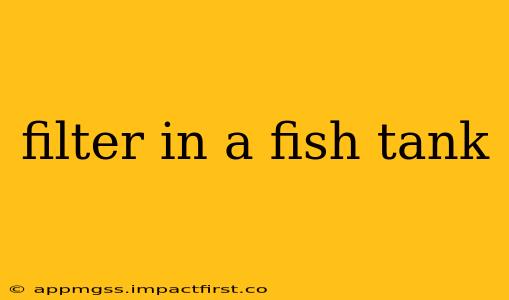Maintaining a clean and healthy fish tank environment is crucial for the well-being of your aquatic pets. A vital component of this process is the filter. This comprehensive guide delves into the world of fish tank filters, exploring different types, their functions, and how to choose the right one for your aquarium.
What is a Fish Tank Filter and Why Do I Need One?
A fish tank filter is a device designed to mechanically, biologically, and chemically purify the water in your aquarium. It removes waste products like ammonia, nitrite, and nitrate, which are toxic to fish. It also removes uneaten food, decaying plant matter, and other debris that would otherwise cloud the water and contribute to poor water quality. Without a properly functioning filter, your fish are at risk of disease and death. Essentially, it's the heart of a healthy aquarium ecosystem.
What are the Different Types of Fish Tank Filters?
Several filter types cater to various aquarium sizes and needs. Understanding their differences helps you make an informed choice:
1. Hang-on-Back (HOB) Filters:
These are external filters that hang on the back of the tank, making them easy to install and maintain. They're suitable for smaller to medium-sized aquariums and generally offer good filtration for the price.
2. Internal Filters:
Placed inside the tank, these filters are compact and ideal for smaller tanks or those with limited space. They are often less powerful than HOB filters but still effective for smaller setups.
3. Undergravel Filters (UGF):
These filters use a porous plate placed under the substrate to draw water upward through the gravel, promoting beneficial bacterial growth within the gravel bed itself. While effective, they require more maintenance and aren't as popular as other types.
4. Canister Filters:
These are powerful external filters that sit on the floor and use a series of tubes to pump water through a larger filter media basket. They are excellent for larger tanks and provide superior filtration, but are more expensive and complex to install and maintain.
5. Sump Filters:
These are typically used in larger, more advanced setups, involving a separate tank (the sump) placed beneath the main aquarium. They offer exceptional filtration capacity and flexibility for customization.
What are the Stages of Filtration?
Most effective filters employ a multi-stage approach, encompassing:
1. Mechanical Filtration:
This stage removes larger debris like fish waste, uneaten food, and other visible particles using mechanical components such as filter pads or sponges.
2. Biological Filtration:
This is crucial for converting toxic ammonia and nitrite into less harmful nitrate. Beneficial bacteria colonies reside within the filter media (like bio-media or ceramic rings), breaking down these harmful compounds.
3. Chemical Filtration:
This stage uses activated carbon or other filter media to remove dissolved impurities, such as chlorine, medications, or discoloration from the water.
How Often Should I Clean My Fish Tank Filter?
Cleaning frequency depends on the filter type and the size of your tank. Generally, you should clean or replace filter media (sponges, pads) every 2-4 weeks, while the filter housing should be rinsed as needed. Never clean all the media at once, as this will kill beneficial bacteria and cause a potentially harmful ammonia spike. Always use aquarium-safe water when rinsing.
What are the Signs My Fish Tank Filter Needs Replacing?
Signs your filter needs replacing include reduced water flow, visible clogging of filter media, persistent cloudiness in the water, or a strong unpleasant odor.
How Do I Choose the Right Fish Tank Filter for My Aquarium?
Choosing the right filter depends on several factors, including tank size, the number and type of fish, and your budget. Always consult a reputable aquarium guide or expert for personalized recommendations based on your specific setup.
Remember, a properly functioning filter is the cornerstone of a healthy and thriving aquarium environment. By understanding different filter types, maintenance needs, and how they function, you can ensure your fish live long, happy lives!
